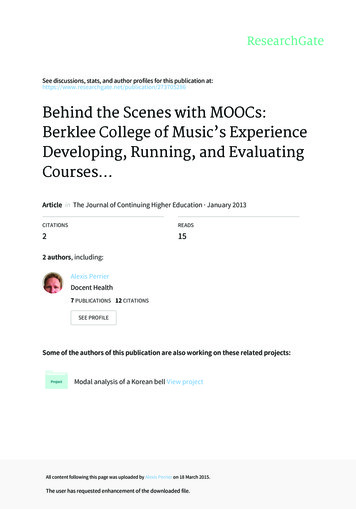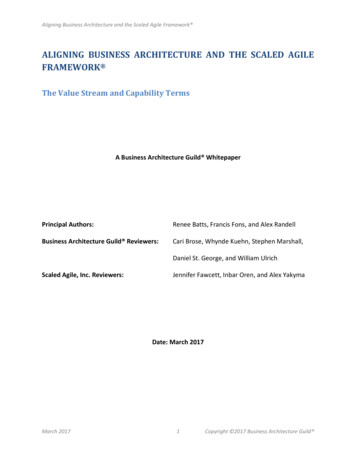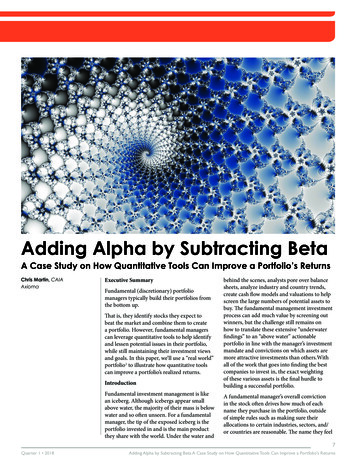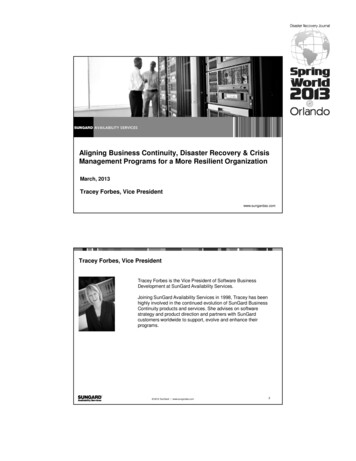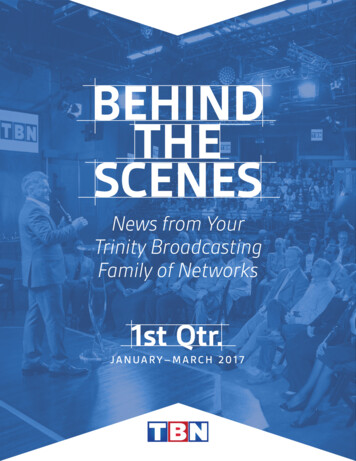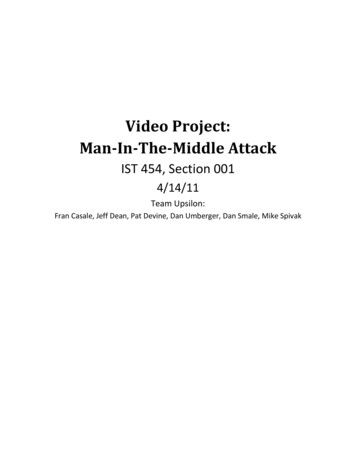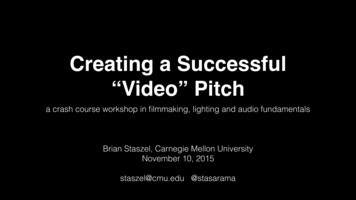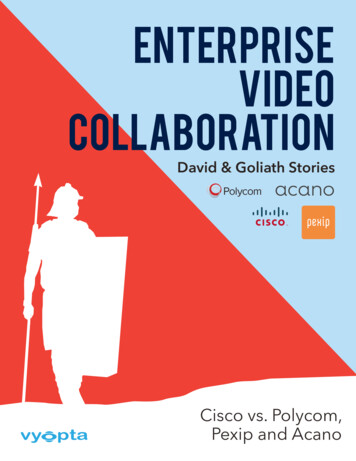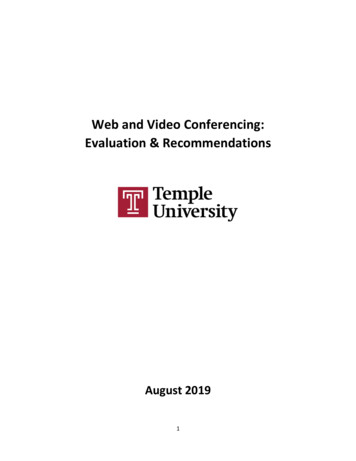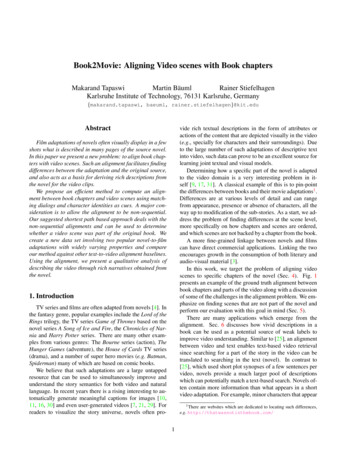
Transcription
Book2Movie: Aligning Video scenes with Book chaptersMakarand TapaswiMartin BäumlRainer StiefelhagenKarlsruhe Institute of Technology, 76131 Karlsruhe, Germany{makarand.tapaswi, baeuml, rainer.stiefelhagen}@kit.eduAbstractvide rich textual descriptions in the form of attributes oractions of the content that are depicted visually in the video(e.g., specially for characters and their surroundings). Dueto the large number of such adaptations of descriptive textinto video, such data can prove to be an excellent source forlearning joint textual and visual models.Determining how a specific part of the novel is adaptedto the video domain is a very interesting problem in itself [9, 17, 31]. A classical example of this is to pin-pointthe differences between books and their movie adaptations1 .Differences are at various levels of detail and can rangefrom appearance, presence or absence of characters, all theway up to modification of the sub-stories. As a start, we address the problem of finding differences at the scene level,more specifically on how chapters and scenes are ordered,and which scenes are not backed by a chapter from the book.A more fine-grained linkage between novels and filmscan have direct commercial applications. Linking the twoencourages growth in the consumption of both literary andaudio-visual material [3].In this work, we target the problem of aligning videoscenes to specific chapters of the novel (Sec. 4). Fig. 1presents an example of the ground truth alignment betweenbook chapters and parts of the video along with a discussionof some of the challenges in the alignment problem. We emphasize on finding scenes that are not part of the novel andperform our evaluation with this goal in mind (Sec. 5).There are many applications which emerge from thealignment. Sec. 6 discusses how vivid descriptions in abook can be used as a potential source of weak labels toimprove video understanding. Similar to [25], an alignmentbetween video and text enables text-based video retrievalsince searching for a part of the story in the video can betranslated to searching in the text (novel). In contrast to[25], which used short plot synopses of a few sentences pervideo, novels provide a much larger pool of descriptionswhich can potentially match a text-based search. Novels often contain more information than what appears in a shortvideo adaptation. For example, minor characters that appearFilm adaptations of novels often visually display in a fewshots what is described in many pages of the source novel.In this paper we present a new problem: to align book chapters with video scenes. Such an alignment facilitates findingdifferences between the adaptation and the original source,and also acts as a basis for deriving rich descriptions fromthe novel for the video clips.We propose an efficient method to compute an alignment between book chapters and video scenes using matching dialogs and character identities as cues. A major consideration is to allow the alignment to be non-sequential.Our suggested shortest path based approach deals with thenon-sequential alignments and can be used to determinewhether a video scene was part of the original book. Wecreate a new data set involving two popular novel-to-filmadaptations with widely varying properties and compareour method against other text-to-video alignment baselines.Using the alignment, we present a qualitative analysis ofdescribing the video through rich narratives obtained fromthe novel.1. IntroductionTV series and films are often adapted from novels [4]. Inthe fantasy genre, popular examples include the Lord of theRings trilogy, the TV series Game of Thrones based on thenovel series A Song of Ice and Fire, the Chronicles of Narnia and Harry Potter series. There are many other examples from various genres: The Bourne series (action), TheHunger Games (adventure), the House of Cards TV series(drama), and a number of super hero movies (e.g. Batman,Spiderman) many of which are based on comic books.We believe that such adaptations are a large untappedresource that can be used to simultaneously improve andunderstand the story semantics for both video and naturallanguage. In recent years there is a rising interesting to automatically generate meaningful captions for images [10,11, 16, 30] and even user-generated videos [7, 21, 29]. Forreaders to visualize the story universe, novels often pro-1 There are websites which are dedicated to locating such differences,e.g. http://thatwasnotinthebook.com/1
A Song of Ice and Fire (Book 1)Figure 1. This figure is best viewed in color. We present the ground truth alignment of chapters from the first novel of A Song of Ice and Fire to the first season of the TV seriesGame of Thrones. Book chapters are depicted on the lower axis with tick spacing corresponding to the number of words in the chapter. As the novel follows a point-of-viewnarrative, each chapter is color coded based on the character. Chapters with a red background (see 8, 18, 42) are not represented in the video adaptation. The ten episodes (E01– E10) of the season 1 corresponding to the first novel are plotted on the top axis. Each bar of color represents the location and duration of time in the video which correspondsto the specific chapter from the novel. A line joining the center of the chapter to the bar indicates the alignment. White spaces between the colored bars indicate that those scenesare not aligned to any part of the novel: almost 30% of all shots do not belong to any chapter. Another challenge is that chapters can be split and presented in multiple scenes(e.g., chapter 37). Note the complexity of the adaptation and how the video does not necessarily follow the book chapters sequentially. We will model these intricacies and use anefficient approach to find a good alignment.66 67 68 69 70 71 72 7364 6539 40 41 42 43 44 45 46 47 48 4950 51 52 5335 36 37 3833 34323121 22 23 24 25 26 27 28 29 305 6 7 8 9 1011 12 13 14 15 16 1718 19 201 2 3 4Chapters5455 56 57 58 59 6061 6263E10E09E08E07E06EpisodesGame of Thrones (Season 1)E05E04E03E02E01in the video are often un-named, however, can be associatedwith a name by leveraging the novels. Finally, the alignmentwhen performed on many films and novels together can beused to study the task of adaptation itself and, for example,characterize different screenwriters and directors.2. Related workIn recent years, videos and accompanying text are an increasingly popular subject of research. We briefly reviewand discuss related work in the direction of video analysisand understanding using various sources of text.The automatic analysis of TV series and films has greatlybenefited from external sources of textual information. Fantranscripts with subtitles are emerging as the de facto standard in automatic person identification [6, 8, 19, 24] and action recognition [5, 12]. They also see application in videosummarization [28] and are used to understand the scenestructure of videos [13]. There is also work on aligningvideos to transcripts in the absence of subtitles [23].The last year has seen a rise in joint analysis of text andvideo data. [22] presents a framework to make TV seriesdata more accessible by providing audio-visual meta dataalong with three types of textual information – transcripts,episode outline and video summaries. [25] introduces andinvestigates the use of plot synopses from Wikipedia to perform video retrieval. The alignment between sentences ofthe plot synopsis and shots of the video is leveraged tosearch for story events in TV series. A new source of text inthe form of descriptive video service used to help visuallyimpaired people watch TV or films is introduced by [20].In the domain of autonomous driving videos, [14] parsestextual queries as a semantic graph and uses bipartite graphmatching to bridge the text-video gap, ultimately performing video retrieval. Very recently, an approach to generatetextual descriptions for short video clips through the use ofConvolutional and Recurrent Neural Networks is presentedin [29]. While the video domains may be different, the improved vision and language models have spiked a clear interest in co-analyzing text and video data.Adapting a novel to a film is an interesting problem inthe performing arts literature. [9, 17, 31] present variousguidelines on how a novel can be adapted to the screen ortheater2 . Our proposed alignment is a first step towards automating the analysis of such adaptations at a large scale.Previous works in video analysis almost exclusively dealwith textual data which is derived from the video. This often causes the text to be rather sparse owing to limited human involvement in its production. One key difference inanalyzing novels – as done in this work – is that the videois derived from the text (or, both are derived from the core2 http://www.kvenno.is/englishmovies/adaptation.htm is a nice summary in terms of the differences and freedom thatdifferent medium may use while essentially telling the same story.
storyline). This usually means that the available textual description is much more complete which has both advantages(more details) and disadvantages (not every part of the textneeds to be present in the video). We think that this ultimately provides a powerful source for improving simultaneous semantic understanding of both text and video.Closest to our alignment approach are two works whichuse dynamic programming (DP) to perform text-to-videoalignment. Sankar et al. [23] align videos to transcriptswithout subtitles; and Tapaswi et al. [25] align sentencesfrom the plot synopses to shots of the video. However, bothmodels make two strong assumptions: (i) sentences andvideo shots appear sequentially; (ii) every shot is assignedto a sentence. This is often not the case for novel-to-filmadaptations (see Fig. 1). We specifically address the problem of non-sequential alignments in this paper. To the bestof our knowledge, this is also the first work to automaticallyanalyze novels and films, to align book chapters with videoscenes and as a by-product derive rich and unrestricted attributes for the visual content.other hand, HP is very character centric with a large chunkof the story revolving around the main character (Harry).The story and the adaptation are thus relatively sequential.Some statistics of the data set can be found in Sec. 5.3. Data set and preprocessing3.3. Film dialog parsingWe first briefly describe our new data set followed bysome necessary pre-processing steps.3.1. A new Book2Movie data setAs this is the first work in this direction, we create a newdata set, comprising of two novel-to-film/series adaptations: GOT: Season 1 of the TV series Game of Thrones corresponds to the first book of the A Song of Ice and Fireseries, titled A Game of Thrones. Fig. 1 shows our annotated ground truth alignment for this data. HP: The first film and book of the Harry Potter series –Harry Potter and the Sorcerer’s Stone. A figure similarto Fig. 1 is included in the supplementary material.Our choice of data is motivated by multiple reasons.Firstly, we consider both TV series and film adaptationswhich typically have different filming styles owing to thestructure imposed by episodes. There is a large disparity inthe sizes of the books (GOT source novel is almost 4 timesas big as HP), and this is also reflected in the total runtimeof the respective videos (9h for GOT vs. 2h30m for HP).Secondly, the stories are targeted towards different audiences and thus their language and content differs vastly. Thefirst book of the Harry Potter series caters towards childrenwhile the same cannot be said about A Game of Thrones.Finally, while both stories are from the fantasy anddrama genre, they have their own unique worlds and different writing styles. GOT presents multiple sub-stories thattake place in different locations in the world at the sametime. This allows for more freedom in the adaptation of thesub-stories creating a complex alignment pattern. On the3.2. Scene detectionWe consider shots as the basic unit of video processingand they are used to annotate the ground truth novel-to-filmalignment. Due to the large number of shots that films contain (typically more than 2000), we further group shots together and use video scenes as basis for the alignment.We perform scene detection using the dynamic programming method proposed in [26]. The method optimizes theplacement of scene boundaries such that shots within ascene are most similar in color and shot threads are not split.We sacrifice on granularity and induce minor errors owing to wrong scene boundary detection. However, the usageof scenes reduces complexity of the alignment algorithm,and facilitates stronger cues obtained by an average overmultiple shots in the scene.We extract character dialogs from the video using subtitles which are included in the DVD. We convert subtitles into dialogs based on a simple, yet widely followedset of rules. For example, a two line subtitle whose linesstart with “–” are spoken by different characters. Similarly,we also group subtitles appearing consecutively (no timespacing between the subtitles) until the sentence is completed. These subtitle-dialogs are one video cue to performthe alignment.3.4. Novel dialog parsingWe follow a hierarchical method for processing the entire text of the novel. We first divide the book into chaptersand each chapter into paragraphs. For the alignment we restrict ourselves at the level of chapters.Paragraphs are essentially of two types: (i) with dialogor (ii) with only narration.Dialogs in paragraphs are indicated by the presence ofquotation marks “ and ”. Each sentence in the dialog istreated separately. These text-based dialogs are used as analignment cue along with the video dialogs.The narrative paragraphs usually set the scene, describethe characters, and back stories. They are our majorsource of attribute labels (see Sec. 6). We process the entire book with part-of-speech tagging using the StanfordCoreNLP [2] toolbox. This provides us with the necessaryadjective tags for extracting descriptions.4. Aligning book chapters to video scenesWe propose a graph-based alignment approach to matchchapters of a book to scenes of a video. Fig. 2 presents an
Figure 2. Alignment cues: We present a small section of the GOT novel, chapter 2 (left) and compare it against the first episode of theadaptation (subtitles shown on the right). Names in the novel are highlighted with colors for which we expect to find corresponding facetracks in the video. We also demonstrate the dialog matching process of finding the longest common subsequence of words. The numberof words and the score (inverted term frequency) are displayed for one such matching dialog. This figure is best viewed in color.overview of the cues used to perform the alignment.For a specific novel-to-film adaptation, let NS be thenumber of scenes and NC the number of chapters. Our goalis to find a chapter c s which corresponds to each scene sc s arg maxc { ,1.NC }φ(c,s) ,(1)subject to certain story progression constraints (discussedlater). All scenes which are not part of the original novelare assigned to the (null) chapter. φ(c,s) captures the similarity between the chapter c and scene s.4.1. Story charactersCharacters play a very important role in any story. Similar to the alignment of videos to plot synopses [25], wepropose to use name mentions in the text and face tracks inthe video to find occurrences of characters.Characters in videos To obtain a list of names whichappear in each scene, we first perform face detection andtracking. Following [27], we align subtitles and transcriptsand assign names to “speaking faces”. We consider allnamed characters as part of our cast list. As feature, weuse the recently proposed VF2 face track descriptor [18] (aFisher vector encoding of dense SIFT features with videopooling). Using the weakly labeled data obtained fromthe transcripts, we train one-vs-all linear Support VectorMachine (SVM) classifiers for each character and performmulti-class classification on all tracks. Tracks which have alow confidence towards all character models (negative SVMscores) are classified as “unknown”.Sec. 5 presents a brief evaluation of face track recognition performance.Finding name references in the novel Using the list ofcharacters obtained from the transcripts and along with theproper noun part-of-speech tags, finding name mentions inthe book is fairly straightforward. However, complex stories – especially with multiple people from the same family – can contain ambiguities. For example, in Game ofThrones, we see that Eddard Stark is often referred to asNed, or addressed with the title Lord Stark. However, astitles can be passed on, his son Robb is also referred to asLord Stark in the same book. We weight the name mentions based on their types (ordered from highest to lowest):(i) full name; (ii) only first name; (iii) alias or titles; (iv) andonly last name. The actual search for names is performedby simple text matching of complete words.Matching For every scene and chapter, we count thenumber of occurrences for each character. We stack themas “histograms” of dimension NP (number of people). Forscenes, we count the number of face tracks QS RNS NP ,and for chapters we obtain weighted name mentions QC RNC NP . We normalize the occurrence matrices such thatthe row-sum equals 1, and then compute Euclidean distancebetween them. Finally, we normalize the distance and obtain our identity based similarity score as φI(c,s) 2 kqS (s) qC (c)k2 ,(2)where qS (s) stands for row s of matrix QS . We use thisidentity-based similarity measure φI RNC NS betweenevery chapter c and scene s to perform the alignment.4.2. Dialog matchingFinding an identical dialog in the novel and video adaptation is a strong hint towards the alignment. While matching dialogs between the novel and film sounds easy, oftenthe adaptation changes the presentation style so that veryfew dialogs are reproduced verbatim. For example, in GOT,we have 12,992 dialogs in the novel and 6,842 in the video.
Figure 3. Illustration of the graph used for alignment. The background gradient indicates that we are likely to reach nodes in thelighter areas while nodes in the darker areas are harder to access.Of these, only 308 pairs are a perfect match with 5 wordsor more, while our following method finds 1,358 pairs withhigh confidence.We denote the set of dialogs in the novel and video byDN and DV respectively. Let W N and W V be the corresponding total number of words. We compute the termfrequency [15] for each word w in the video dialogs asψ V (w) #w/W V ,(3)where #w is the number of occurrences of the word. Asimilar term frequency ψ N (w) is computed for the novel.To quantify the similarity between a pair of dialogs, n DN from the novel and v DV from the video, we findthe longest common subsequence between them (see Fig. 2)and extract the list of matching words Sn,v . However, stopwords such as of, the, for can produce false spikes in theraw count Sn,v . We counter this by incorporating invertedterm frequencies and compute a similarity score betweeneach dialog pair (n, v) asXφD (log ψ N (w) log ψ V (w))/2 . (4)(n,v) w Sn,vFor the alignment, we trace the dialogs to their respectivebook chapters and video scenes, and accumulate themX XφDφD(5)(c,s) (n,v) ,n cD v sDwhere cD and sD is the set of dialogs in the chapterand scene respectively. We finally normalize the obtaineddialog-based similarity matrix φD RNC NS .4.3. Alignment as shortest path through a graphWe model the problem of aligning the chapters of a bookto scenes of a video (Eq. 1) as finding the shortest path in asparse directed acyclic graph (DAG). The edge distances ofthe graph are devised in a way that the shortest path throughthe graph corresponds to the best matching alignment. Aswe will see, this model allows us to capture all the nonsequential behavior of the alignment while easily incorporating information from the cues and providing an efficientsolution. Fig. 3 illustrates the nodes of the graph along witha glimpse of how the edges are formed.The main graph (with no frills) consists NC · NS nodesordered as a regular matrix (green nodes in Fig. 3) whererows represent chapters (indexed by c) and columns represent scenes (indexed by s). We create an edge from everynode in column s to all nodes in column s 1 resulting in atotal of NC2 ·(NS 1) edges. These edge transitions allow toassign each scene to any chapter, and the overall alignmentis simply the list of nodes visited in the shortest path.Prior Every story has a natural forward progressionwhich an adaptation (usually) follows, i.e. early chapters ofa novel are more likely to be presented earlier in the videowhile chapters towards the end come later. We initialize theedges of our graph with the following distances.The local distance from a node (c, s) to any node inthe next column (c0 , s 1) is modeled as a quadratic distance and deals with transitions which encourage neighboring scenes to be assigned to the same or nearby chapters.d(c,s) (c0 ,s 1) α c0 c 2,2 · NC(6)where dn n0 denotes the edge distance from node n to n0 .α serves as a non-zero distance offset from which we willlater subtract the similarity scores.Another influence of the prior is a global likelihood ofbeing at any node in the graph. To incorporate this, we multiply all incoming edges of node (c, s) by a Gaussian factor (s µs )2g(c, s) 2 exp .(7)2 · NS2µs dc · NS /NC e and the 2 exp(·) ensures the multiplying factor g 1. This results in larger distances to gotowards nodes in the top-right or bottom-left corners.Overall, the distance to come to any node (c, s) is influenced by where the edge originates (dn (c,s) , Eq. 6) andthe location of the node itself (g(c, s), Eq. 7).Unmapped scenes Adaptations provide creative freedomand thus every scene need not always stem from a specificchapter from the novel. For example, in GOT about 30%of the shots do not have a corresponding part in the novel(c.f . Fig. 1). To tackle this problem, we add an additionallayer of NS nodes to our graph (top layer of blue nodes inFig. 3). Inclusion of these nodes allows us to maintain thecolumn-wise edge structure while also providing the additional feature of unmapped scenes. The distance to arrive atthis node from any other node is initialized to α µg , whereµg is the average value of the global influence Eq. 7.
Using the alignment cues The shortest path for the current setup of the graph without external influence assignsequal number of scenes to every chapter. Due to its structure, we refer to this as the diagonal prior. We now use theidentity (Eq. 2) and dialog matching (Eq. 4) cues to lowerthe distance of reaching a high scoring node. For example, anode which has multiple matching dialogs and the same setof characters is very likely to depict the same story and bea part of correct scene-to-chapter alignment. Thus reducingthe incoming distance to this node encourages the shortestpath to go through it.For every node (c, s) with a non-zero similarity score,we subtract the similarity score from all incoming edges,thus encouraging the shortest path to go through this node.Xdn0 (c,s) dn0 (c,s) wM φM(8)(c,s) ,Mwhere φM(·) is the similarity score of modality M with weightwM 0 and n0 (·, s 1) is the list of nodes from theprevious scene with an edge to (c, s). TheP sum of weightsacross all modalities is constrained as M wM 1. Inour case, the modalities comprise of dialog matching andcharacter identities, however, such an approach allows toeasily extend the model with more cues.When the similarity score between scene s and all chapters is low, it indicates that the scene might not be a part ofthe book. We thus modify the incoming distance to the node( , s) as follows:!XXdn0 ( ,s) dn0 ( ,s) wM max 0, 1 φM.(c,s)Mc(9)This encourages the shortest path to assign the scene s tothe null chapter class c s .Implementation details We use Dijkstra’s algorithm tosolve the shortest path problem. For GOT, our graph hasabout 27k nodes and 2M edges. Finding the shortest path isvery efficient and takes less than 1 second. Our initializationdistance parameter α is set to 1. The weights wM are notvery crucial and result in good alignment performance for alarge range of values.5. EvaluationWe now present evaluation of our proposed alignmentapproach on the data set [1] described in Sec. 3.1.VIDEOBOOKFace-IDExternal source/sink Initializing the shortest path withinthe main graph would force the first scene to belong to thefirst chapter, and the last scene to the last chapter. However, this need not be true. To prevent this, we include twoadditional source and sink nodes (red nodes in Fig. 3). Wecreate NC additional edges each to transit from the sourceto column s 1 and from column s NS to the sink. Thedistances of these edges are based on the global distance.GOTHPGOTHPduration#scenes#shots (#nobook)8h 58m2h 32m3691389286 (2708)2548 (56)#chapters#words#adj, #verb7317293k78k17k, 59k4k, 17k#characters #tracks (unknown)GOTHP954611094 (2174)3777 (843)id accuracy67.672.3Table 1. An overview of our data set. The table is divided intothree sections related to information about the video, the book andthe face identification scheme.Data set statistics Table 1 presents some statistics of thetwo novel-to-video adaptations. The GOT video adaptationand book is roughly four times larger than that of HP. Amajor difference between the two adaptations is the fractionof shots in the video which are not part of a book chapter.For GOT the number of shots not in the book (#nobook) aremuch higher at 29.2% than as compared to only 2.2% forHP. Both novels are a large resource for adjectives (#adj)and verbs (#verb).Face ID performance Table 1 (Face-ID) shows the overall face identification performance in terms of track-levelaccuracy (fraction of correctly labeled face tracks).The face tracks involve a large number of people andmany unknown characters, and our track accuracy of around70% is on par with state-of-the-art performance on complexvideo data [18]. Additionally, GOT and HP are a new addition to the existing data sets on person identification and wewill make the tracks and labels publicly available [1].5.1. Ground truth and evaluation criterionThe ground truth alignment between book chapters andvideos is performed at the shot level. This provides a finegrained alignment independent of the specific scene detection algorithm. The scene detection only helps simplify thealignment problem by reducing the complexity of the graph.We consider two metrics. First, we measure the alignment accuracy (acc) as the fraction of shots that are assignedto the correct chapter. This includes shot assignments to .We also emphasize on finding shots that are not part of thebook (particularly for GOT). Finding these shots is treatedlike a detection problem, and we use precision (nb-pr) andrecall (nb-rc) measures.5.2. Book-to-video alignment performanceWe present the alignment performance of our approachin Table 2, inspect the importance of dialog and identitycues, and compare the method against multiple baselines.As discussed in Sec. 3.2, for the purpose of alignment,we perform scene detection and group shots into scenes.
Game of Thrones (Season 1) - EpisodesE01E02E03E04E05E06E07E08E09E10ground truthpriorDTW3prior ids dlgsFigure 4. This figure is best viewed in color. We visualize the alignment as obtained from various methods. The ground truth alignment(row 1) is the same as presented in Fig. 1. Chapters are indicated by colors, and empty areas (white spaces) indicate that those shot are notpart of the novel. We present alignment performance of three methods: prior (row 2), DTW3(row 3) and our approach prior ids dlgs(row 4). The color of the first sub-row for each method indicates the chapter to which every scene is assigned. Comparing vertically againstthe ground truth we can determine the accuracy of the alignment. For simplicity, the second sub-row of each method indicates whether thealignment is correct (green) or wrong (red).accGOTnb-pr nb-rcaccHPnb-prnb-rcscenes upper95.197.986.496.740.07.1priorprior idsprior dlgsids dlgsprior ids �0.03.60.00.0MAX [25]MAX [25] DTW3 �0.0––0.0–methodTable 2. Alignment performance in terms of overall accuracy ofshots being assigned book chapters (acc). The no-book precision(nb-pr) and no-book recall (nb-rc) are for shots which are not partof the book. See Sec. 5.2 for a detailed discussion.However, errors in the scene boundary detection can lead tosmall alignment errors measured at the shot level. Methodscenes upper is the best possible alignment performancegiven the scene boundaries and we observe that we do notlose much in terms of overall accuracy.Shortest-path based As a baseline (prior), we evaluatethe alignment obtained from our graph after initializingedge distances with local and global priors. The alignmentis an equal distribution of scenes among chapters. For bothGOT and HP we observe bad performance suggesting thedifficulty of the task. The prior distances modified with thedialog matching cue (prior dlgs) outperform prior withcharacter identities (prior ids) quite significantly. An explanation of this is (i) inaccurate face track recognition; and(ii) similar names appearing in the text (e.g. Jon Arryn, JonUmber and Jon Snow are three characters in GOT). However the fusion of the two cues prior ids dlgs performsbest. Note that we are quite successful in finding shots thatare not part of the book. If we disable the global priorwhich provides structure to the distances (ids dlgs), weobtain comparable performance indicating that the cues areresponsible for
3.1. A new Book2Movie data set As this is the first work in this direction, we create a new data set, comprising of two novel-to-film/series adaptations: GOT: Season 1 of the TV series Game of Thrones cor-responds to the first book of the A Song of Ice and Fire series, titl
